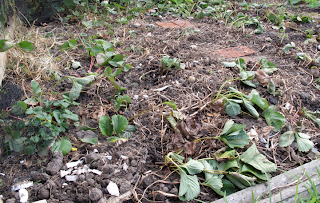We're due for our third weather bomb in five weeks (a fortnightly foreboding forecast). In preparation for this latest blow I was finishing up some scribers to insure that wind-driven rain would not get in beside our windows. In the picture below, the scriber is the lapped piece of wood that serves as Yin to the weatherboards' Yang. Making scribers is very labour intensive as each one has to be individually measured and cut.

While I was putting the last coat of paint on the last four scribers, a song came on the radio that I've probably heard a hundred times before: Paul McCartney and Wings, "With a Little Luck." Yeah, whatever, we could all use a little luck...but then I heard a line in the song I had never really noticed before. It leapt out of the melody and grabbed my attention.
The willow turns his back on inclement weather;
And if he can do it, we can do it, just me and you
And I thought of the willow in the western corner of our section.
Unfortunately, due to the sun angle in this photo you can't get the full truth and imagery of McCartney's words. This tree grows on about a 45 degree angle, but still it is the tallest tree on our property. It's survival strategy is to turn its back on inclement (love that word, especially in a rock 'n roll song) weather. Perhaps the reason that line resonated with me more than ever before is that this has become my strategy for survival as well. This strategy takes a number of forms, from the literal to the figurative.
First and foremost, our home has be redesigned with its face to the sun and its back to the cold southerlies. (We added glazing to the north and removed glazing from the south.) Ironically, the smiling "face" of our home is our backyard and the "back" is the front door.
That's OK, because much of our world is upside down now, it only makes sense to design for 180 degrees away from the status quo. That is another way of turning one's back to inclement weather. In other words, it means saying "No thank you" to consumerism, debt, globalization, etc. Someone like Nicole Foss warns of a financial storm that will be a weather bomb of a different kind. Taking a lesson from the willow, one strategy is to turn one's back to it. I don't take this from a survivalist perspective, but more from a '
Transition Culture' perspective.
I mention Nicole not just because of her message on
The Automatic Earth, (she writes under the pen name, Stoneleigh) but also because she and her partner Raul (Ilargi) are coming to Whanganui next week to speak to our community.
I also mention Nicole and Raul because the name of their website, The Automatic Earth, comes from a Paul Simon song with the lyrics: "The boy in the bubble and the automatic earth." I think that is cool, because they write about economic bubbles, debt deflation, etc.
As for us, we write about sustainable living, debt avoidance, low budget/high performance building/renovation and food production. We write about practical ways to turn one's back on inclement weather of all kinds, be they weather bombs, financial tsunamis, volatile energy and food prices, etc. Perhaps I should change the name of this blog to, With a Little Luck.
Indeed, along with the best possible preparation for the challenges ahead, it will also take a little luck, and - as the lyrics below make clear - people working together. We are all about building community and I know Nicole and Raul put a big emphasis on that as well.
With a little luck, we can help it out.
We can make this whole damn thing work out.
With a little love, we can lay it down.
Can't you feel the town exploding?
There is no end to what we can do together.
There is no end, there is no end.
The willow turns his back on inclement weather;
And if he can do it, we can do it, just me and you,
And a little luck, we can clear it up.
We can bring it in for a landing,
With a little luck, we can turn it on.
There can be no misunderstanding.
There is no end to what we can do together.
There is no end, there is no end.
The willow turns his back on inclement weather;
We can do it, just me and you.
Below you'll find a series of images that show some of the recent ways we've been turning our back on "inclement weather."
Peace, Estwing
Curing pumpkins for winter storage.
Biggest red onion I've ever seen. Go compost!
Salad greens awaiting Nicole and Raul.
1,000 litres of water storage.
Inaugural lighting of Shacklock 501 coincided with a 6 hour power outage.
We baked 3 loaves of bread and made a huge vege soup to celebrate the power outage.


















































